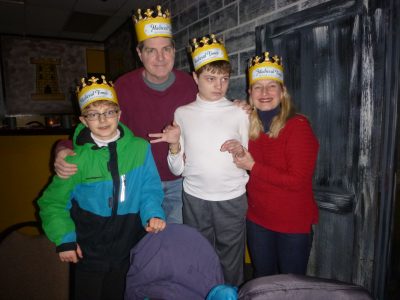
Fifteen years ago this fall an event occurred which forever altered the course of my life, and my son’s. I had taken my sixteen-month-old to see his pediatrician for a scrip for his recurring case of reflux. Instead I left with several badly mismatched copies of articles with the word “autism” in the title, and not a word of encouragement as I packed up our things and left the office.
Although the way I was told about my son’s disability was brutal, I will always be grateful his doctor saw more than just speech delay in my small son.
I have two boys on the autism spectrum, an almost sixteen-year-old with severe autism, and a twelve-year-old on the milder end of the spectrum. With both boys I was fortunate to receive diagnoses of ASD before they turned two, which back in the early “thousands” wasn’t always so easy to come by. I am positive that early diagnosis and intervention contributed greatly to both of my boys’ later successes in life. Despite severe autism, OCD, and tics my teenager is a mostly happy soul, does well in his school program, well at home, and we are able to take him out into the community with little drama. My tween is on honor roll, has friends, and participates in many activities both in school and out.
|
|
I believe there are several factors that have led to their collective happiness and successes. Early diagnosis and intervention were key. Never giving up on their leading happy productive lives, and taking the steps every day to ensure this would happen (even when most times my husband and I were exhausted), was crucial. Their intrinsic desires to enjoy life and the people who support them also played a large role in their content demeanors.
Perhaps the key ingredient however that has brought us to this point is that their father and I got some great advice when our youngest was first diagnosed. We were told there would be many suggestions on how to treat his autism, from diets to an early intervention mode of therapy. We were advised to read up on everything autism-related as much as possible, but as we navigated our way through this autism path to remember one very important thing.
Try many things, but always keep an open mind.
When we moved to New Jersey from Virginia when Justin was two he had a few sounds, but no words. I had been trying to teach him sign language for the better part of a year at that point, and although he had a few signs, he was far from consistent in using them. I had read that some studies suggested autistic children had a far better chance of speaking if they used sign rather than other methods of communication, and I was determined this would be his technique. I thought he just needed more time to master sign language, and was doing hundreds of trials a day to ensure he would.
And then one day at an early intervention meeting at my home about a month after his therapies started one of our fabulous therapists pointed out how little progress he’d made in a year, how he often used the same sign for everything, and how his gross and fine motor issues were more than likely the biggest culprits in his slow learning curve.
It was like a lightbulb went off in my head.
Everyone around the table agreed, and these were therapists with many years of experience at the Douglass Center. It struck me that I had been clinging far more tightly to those few studies than the evidence staring me in the face- my son needed a new method of communication that didn’t require so much manipulation of his hands. Within weeks my son was using PECS, and to this day he communicates his needs beautifully on his iPad with Proloquo to go.
If I hadn’t been open to their advice when he was so young, I’m not sure he’d be at this point today.
I went through a similar experience with my youngest son, who regressed at eighteen months, losing a year’s worth of skills over the space of several weeks. I was ready to dive right into an ABA program with him, but his team of early intervention therapists persuaded me he needed more of a NET or Floortime approach, and they were completely right. He thrived with this therapy, with its more fluid approach and less data taken.
Fortunately by that point, I was less driven by studies and more intent on really looking at my children and ascertaining their individual needs.
Piloting through the world of autism can be frustrating and overwhelming. There have been so many choices my husband and I have had to make regarding our sons’ care, and often we didn’t know if we were making the right one. Keeping an open mind to different approaches to deal with our boys’ issues has served us well this last decade-and-a-half, and it’s an approach we cling to, as every year brings new challenges to one or both our boys. It is really important to be gentle with yourselves if you select the wrong path initially- there’s no autism manual, each child is different, and it’s important to choose whatever approach not only works for your child, but for your entire family.
Whatever you do, remember to keep an open mind.
For more on my family visit my blog at autismmommytherapist.wordpress.com
Follow me on Facebook at Autism Mommy-Therapist

Advertisement

Police, Fire & Courts
Driver Charged With DWI in Fatal Brick Accident; SUV Was In Wrong Lane of Route 70

Police, Fire & Courts
Police ID Victim, 58, in Fatal Brick Car Accident; Suspect Facing DWI Charge









